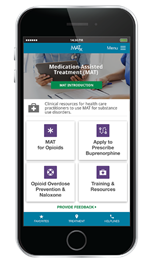MAT is evidence-based and improves patient care by offering an opportunity to better meet the biopsychosocial needs of patients with substance use disorders:

- Better addressing addiction in all areas of healthcare will improve outcomes in other aspects of a person's health. For example, if someone’s heroin use disorder is treated and managed with buprenorphine, they will be more likely to follow up with their primary care provider and successfully manage their other chronic conditions.
- Given that MAT is relatively difficult to access currently, and that the need for MAT greatly outweighs its availability, offering MAT is a business opportunity and a competitive advantage in an increasingly competitive health care landscape where providers and clinics seek to attract patients by offering valued services.
 Implementing a MAT program is an important step to being able to provide comprehensive and integrated care for individuals with substance use disorders. Buy-in from both leadership and front-line health providers is important in implementing a successful MAT program. Oftentimes, this buy-in requires two important elements: 1) knowledge, and 2) will.
Implementing a MAT program is an important step to being able to provide comprehensive and integrated care for individuals with substance use disorders. Buy-in from both leadership and front-line health providers is important in implementing a successful MAT program. Oftentimes, this buy-in requires two important elements: 1) knowledge, and 2) will.
- Knowledge: Knowledge about MAT is important to start a MAT program so that leadership and front-line healthcare providers understand the who/what/why/how of MAT. Similarly, education for patients is also important so that they know what MAT is once it becomes more available.
- Will: The will to support, start, and sustain a MAT program involves making a human, clinical, and business case for why MAT programs are important. This will often originates from hearing personal stories of patients who have benefited, and professional stories of health providers who have seen the benefits of this intervention with their patients. Over time, these stories and experiences feed the will for providers, patients, and leadership to invest the work required to cultivate a strong MAT program.
Some important considerations when planning to implement a MAT program include:
- Administrative – It is important that your site has the necessary approvals and certifications from your oversight agency to offer the MAT you would like to provide. In general, in terms of site certifications, the requirements for providing MAT in the specialty SUD setting are more extensive than in the primary care or specialty mental health settings. For example, for specialty SUD providers operating in the Drug Medi-Cal system:
- Need site to obtain Drug Medi-Cal (DMC) certification.
- Need site to obtain Alcohol and/or Other Drug (AOD) certification.
- If the desire is for MAT to be offered as a component of withdrawal management, need to have site certified for withdrawal management.
- Residential facilities need to obtain approval from the California Department of Health Care Services for Incidental Medical Services prior to offering MAT. As such, if a residential facility wants to offer MAT for withdrawal management, it would need both approvals for Incidental Medical Services and site certification for residential withdrawal management.
- Methadone for addiction (as opposed to pain) can only be prescribed in licensed Opioid Treatment Program settings.
- Staffing – Most prescribers with a Drug Enforcement Agency (DEA) number, such as MDs, DOs, nurse practitioners, and physician assistants, can prescribe MAT. However, certain exceptions exist:
- Buprenorphine prescribers are required to obtain training and a DEA X-number.
- Methadone must be prescribed by physicians, as opposed to non-physician prescribers, in Opioid Treatment Program settings.
- Additionally, changes in program/clinic operations and workflows can oftentimes lead to staff resistance. Furthermore, healthcare providers sometimes have negative attitudes about MAT which limit the establishment of these evidence based programs. It is important to understand and address this resistance, when it arises, in order to ensure multi-level (leadership and front-line staff) buy-in and support.
- For additional details, see "Why isn't MAT more widely used?" in the Overview section of the site, as well as "How to address negative staff attitudes regarding MAT" in the Provider section of this site.
- Clinical – Provider sites offering MAT should have policies and procedures in place to provide an organized framework by which MAT will be delivered according to best practice. Included in the policies and procedures should be a process by which patients offered MAT are connected with substance use providers, when necessary and appropriate, and those who can provide the behavioral interventions recommended to optimize MAT outcomes.
- For additional details, see "What resources and guides exist for primary care and mental health settings?" as well as "What are some examples of successful MAT protocols for specialty substance use treatment settings?" in the Provider sections of the site.
- Training – It is important to have a clear process for both prescriber and non-prescriber staff to be trained on MAT and accompanying policies and procedures. Recommended areas of focus include training on when to refer patients for MAT and how to connect them to behavioral interventions. Given that non-medical staff oftentimes provide patient education and discussion treatment-related issues with patients, they need MAT training as well so they can talk to patients about why medications are important for the treatment of select substance use disorders.
- For additional details, see "What training will staff and prescribers need to begin implementing MAT? What training and technical assistance (TA) resources exist?" in the Provider section of this site.
- Financial – Becoming familiar with the mechanism of billing for MAT services will be important to ensure a sustainable program. Depending on the setting, MAT services may be billed to FFS Medi-Cal (e.g., primary care settings) or Drug Medi-Cal (e.g., Opioid Treatment Program settings). Additionally, depending on the medication, some medications such as long-acting naltrexone and acamprosate require Treatment Authorization Requests (TARs) prior to delivery via Medi-Cal.
- For additional details, see "How do I bill for MAT? How do I work through the Treatment Authorization Request (TAR) process?" in the Provider section of this site.

Adopting new practices presents unique challenges. Learning from the experiences of other programs can help sites implement MAT programs more quickly and effectively. Numerous resources exist to help programs begin implementing MAT. Below are links to some basic checklists, pocket guides, and case studies to help providers get started.

- Toolkit
- SAMHSA MAT Implementation Checklist
- SAMHSA TIP 63: Medications for Opioid Use
- NIATx: Getting Started with Medications for Addiction Treatment – Lessons from Advanced Recovery
- ASAM National Practice Guideline for MAT for Opioid Use
- ASAM Pocketguide
- NIDA: Effective Treatments for Opioid Addiction
- Los Angeles County MAT Hub Referral Process Report
Staff sometimes can have strong feelings about use of MAT and may exhibit resistance. Some strategies to address this resistance include:

- Identify and better understand staff reservations (workload, patient population, lack of familiarity/training, etc.) so they can be acknowledged and addressed.
- Articulate the case for your organization's desire to implement a MAT program, which oftentimes involves improved patient care, clinical processes, and business opportunities.
- Emphasize the resources available to staff to help them be successful with this new priority.
- Identify "MAT champions" within various areas of your organization that are knowledgeable and supportive, and demonstrate a strong and unified commitment to MAT from both leadership and frontline providers across your organization.

Primary Care Buprenorphine Programs
Primary Care MAT Resources
- Recovery Within Reach: Medications for Addiction Treatment of Opioid Addiction Comes to Primary Care
- SUMMIT Protocol for Primary Care Patients with Opioid or Alcohol Use Disorders
- Brief Treatment for Substance Use Disorders: A Guide for Behavioral Health Providers
- Program PC-A MAT Protocols
- Program PC-B MAT Protocols
- General MAT Guidelines
- Patient Flyer - Naloxone
Mental Health MAT Resources
Primary Care and Mental Health MAT Resources in LA County
What are some examples of successful MAT protocols for specialty substance use and other care settings?

Specialty substance use providers generously shared the resources below. These resources include organizational protocols, checklists, and other documents that were developed to ensure high-quality MAT delivery within their MAT program. These resources have been made anonymous and can be used as-is or customized to your agency's specific workflow, policies or procedures.
Specialty SUD Provider Resources
- Program SUD-A MAT Protocols (Suboxone, Withdrawal Management, long-acting naltrexone)
- Program SUD-B MAT Protocols (long-acting naltrexone) - Long-Acting Naltrexone Process
- Program SUD-C MAT Protocols (general policy, long-acting naltrexone)
Primary Care and Mental Health MAT Resources in LA County

The funding for MAT can be complicated. However, understanding this aspect of service delivery is an important part of developing a sustainable MAT program. The attached table was developed to increase the understanding of the MAT funding streams available in Los Angeles County. This may not apply to other counties or jurisdictions.
MAT Reimbursement via Medi-Cal (California's Medicaid) in Los Angeles County (including FQHCs).
For example:
- All MAT medications are available via fee-for-service (FFS) Medi-Cal except for methadone when it is used for addiction, where it can only be offered via Drug Medi-Cal in Opioid Treatment Program settings.
- Some medications are available via Drug Medi-Cal, with an expanded list of medications available via Drug Medi-Cal for counties (such as Los Angeles County) that have opted into the Drug Medi-Cal Organized Delivery System Waiver.
- Long-acting naltrexone is available as a pharmacy benefit through FFS Medi-Cal.
- Additionally, long-acting naltrexone and acamprosate both require Treatment Authorization Requests (TARs) through FFS Medi-Cal. The specialty pharmacies listed below under "Specialty Pharmacies that offer MAT in Los Angeles County" can help to process TARs for MAT.
Treatment Authorization Request (TAR) Resources
The below TAR resources can help programs better understand the TAR process for long-acting naltrexone (aka: Vivitrol).
Specialty Pharmacies that offer MAT in Los Angeles County
Call the Substance Abuse Service Helpline (SASH) at 844-804-7500 to speak with someone who will perform a brief screening and facilitate a referral to an appropriate provisional level of care for SUD treatment.
Refer to the Service and Bed Availability Tool (SBAT), which is a web-based service locator that can be filtered based on level of care, language, service type, and special populations (e.g., criminal justice involved, LGBTQ, perinatal women, etc).
Naloxone is an opioid overdose medication that can reverse respiratory depression and overdoses in a matter of minutes. It does not have abuse potential and is easy-to-use, with minimal side effects beyond opioid withdrawal. Given its profile as a high benefit and low risk medication, it is recommended for a wide variety of patients at-risk for opioid overdose, as well as their family and friends who may be bystanders in the event of an overdose. In particular, naloxone is recommended for the following populations:
- People addicted to opioids, in particular following reduced tolerance (after detoxification, release from incarceration, stopping treatment).
- People who inject opioids.
- People who use prescription opioids, in particular those taking higher doses.
- People who use opioids in combination with other sedating substances, such as benzodiazepines or barbiturates.
- People who use opioids and have medical conditions such as HIV, liver or lung disease or suffer from depression.
- Household members of people in possession of opioids (including prescription opioids).
This lifesaving medication can obtained from prescribers such as MDs, DOs, NPs, and PAs, and can also be furnished by pharmacists that receive training to do so.
Naloxone Patient Flyer
Pharmacy chains in Southern California and California that offer naloxone:
- Ralphs Pharmacies (SoCal) that Furnish Naloxone (*LA County locations highlighted in yellow)
- CVS Pharmacies (CA) that Furnish Naloxone (*LA County locations highlighted in yellow)
Harm Reduction Coalition website
What training will staff and prescribers need to begin implementing MAT? What training and technical assistance (TA) resources exist?

Prescribers and other health and counseling professionals must have the knowledge and skills to effectively and safely implement MAT. Staff must recognize the importance of medications as an evidence-based strategy to prevent relapse to alcohol and opioid use disorders. Several training and TA resources are listed below:
Helpful Websites & Webinars
- MAT: A Blueprint for Change in Los Angeles County
- Webinar Series: Medications for Addiction Treatment
- MAT waiver training
- Providers' Clinical Support System – Medications for Addiction Treatment (PCSSMAT) training and mentoring
- Vivitrol 101: An Introduction to Long Acting Injectable Naltrexone, Desiree Crevecoeur-MacPhail, PhD

Clinical and Technological Supports
- UCSF Clinician Consultation Center for Substance Use
Substance use warmline: 855-300-3595 - Providers' Clinical Support System for MAT (PCSS-MAT)
National training and mentorship project to give prescribers the tools to be able to prescribe MAT